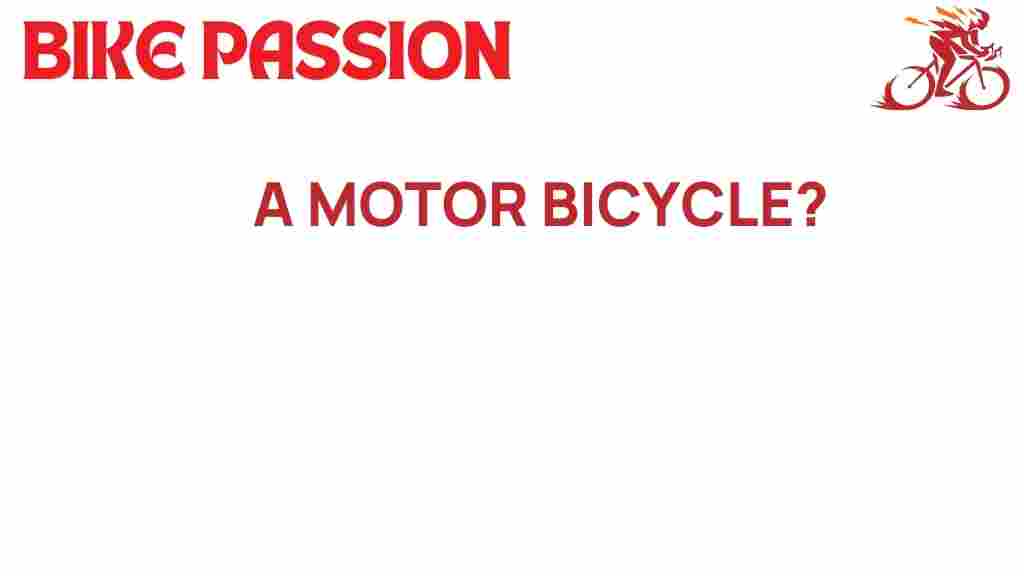Unveiling the Secrets of the Motor Bicycle Revolution
The motor bicycle is more than just a mode of transportation; it represents a significant innovation in the cycling world, blending the traditional elements of cycling with advanced technology. As cities become increasingly congested and the demand for sustainable travel options grows, the motor bicycle stands out as a symbol of efficiency, adventure, and eco-friendliness. In this article, we will explore the evolution of motor bicycles, their design, the technology that powers them, and how they fit into the broader context of sustainable transportation.
The Evolution of Motor Bicycles
The concept of combining a bicycle with a motor has been around for over a century. Initially, these motorized cycles were rudimentary, but technological advancements have transformed them into sophisticated machines. Here’s a brief overview of their evolution:
- Early Days (Late 19th Century): The first motor bicycles emerged in the late 1800s, featuring simple gas engines.
- Post-War Era (1940s-1960s): After World War II, designs became more refined, and electric motors started to gain popularity.
- Modern Innovations (2000s-Present): Today’s motor bicycles utilize cutting-edge technology, including lightweight materials, advanced battery systems, and smart connectivity.
Why Choose a Motor Bicycle?
Motor bicycles offer numerous benefits that make them an attractive choice for many riders:
- Efficiency: With the combination of pedaling and motor assistance, riders can travel longer distances with less effort.
- Environmental Impact: Motor bicycles produce lower emissions compared to cars, promoting sustainability.
- Cost-Effective: They are generally cheaper to maintain and operate than traditional vehicles.
- Health Benefits: Riders still engage in physical activity, improving their fitness while enjoying the ride.
- Adventure: Motor bicycles allow riders to explore new terrains and enjoy the outdoors.
Design and Technology of Motor Bicycles
The design of a motor bicycle plays a crucial role in its functionality and appeal. Here are key design aspects:
- Frame: Lightweight yet durable materials like aluminum and carbon fiber are often used.
- Motor: Electric motors are the most common, providing various levels of assistance.
- Batteries: Modern motor bicycles feature advanced lithium-ion batteries that offer extended range and quick charging times.
- Smart Features: Connectivity options such as GPS, fitness tracking, and app integration enhance the riding experience.
With the rise of technology, many motor bicycles now come equipped with features that make them not just a means of transportation but also a gadget for tech-savvy individuals. Riders can monitor their speed, battery life, and even navigate through their smartphones.
How to Choose the Right Motor Bicycle
Selecting the right motor bicycle involves considering several factors:
- Purpose: Determine whether you’ll use it for commuting, recreation, or off-road adventures.
- Budget: Motor bicycles can range widely in price; set a budget that suits your needs.
- Motor Type: Decide between hub motors and mid-drive motors, each offering distinct advantages.
- Battery Range: Assess how far you plan to travel and choose a model that meets your range requirements.
For more detailed comparisons, you can check out this comprehensive guide on motor bicycles.
Step-by-Step Guide to Getting Started with a Motor Bicycle
Once you’ve chosen your motor bicycle, it’s time to hit the road. Here’s a simple step-by-step guide to getting started:
Step 1: Familiarize Yourself with Your Bicycle
Before riding, take time to understand your motor bicycle’s features, including the control system and safety mechanisms.
Step 2: Safety Gear
Always wear appropriate safety gear, including a helmet, gloves, and reflective clothing, especially when riding in urban areas.
Step 3: Battery Care
Ensure your battery is fully charged before your ride. Regularly check battery health and follow manufacturer guidelines for maintenance.
Step 4: Start Riding
Begin in a safe area to practice balancing and controlling the motor assistance. Adjust the settings to find the right level of support for your needs.
Step 5: Explore
Once comfortable, explore your surroundings. Take advantage of local cycling paths and parks to fully enjoy your motor bicycle.
Troubleshooting Common Issues
While motor bicycles are designed to be user-friendly, you may encounter some common issues. Here are troubleshooting tips:
- Battery Not Charging: Check the charger and connections. If the battery is old, it may need replacing.
- Motor Not Engaging: Ensure the system is powered on and that the battery has sufficient charge.
- Flat Tire: Regularly check tire pressure and inspect for punctures. Replace or repair tires as needed.
- Noisy Operation: Lubricate moving parts and check for loose components.
If problems persist, consult your manufacturer’s manual or seek professional assistance.
Conclusion
The motor bicycle revolution is not just about enhancing the cycling experience; it’s about embracing a new way of thinking about transportation. With innovations in design and technology, motor bicycles are paving the way for more efficient, sustainable, and adventurous travel options. Whether you are commuting to work, exploring new trails, or just enjoying a leisurely ride, the motor bicycle offers a unique blend of fun and functionality. As we continue to prioritize sustainability in our transportation choices, the motor bicycle stands as a testament to what the future holds for cycling and innovation. Embrace the adventure and join the motor bicycle revolution today!
For more information on sustainable transportation options, visit this resource.
This article is in the category Gear and created by BikePassion Team
